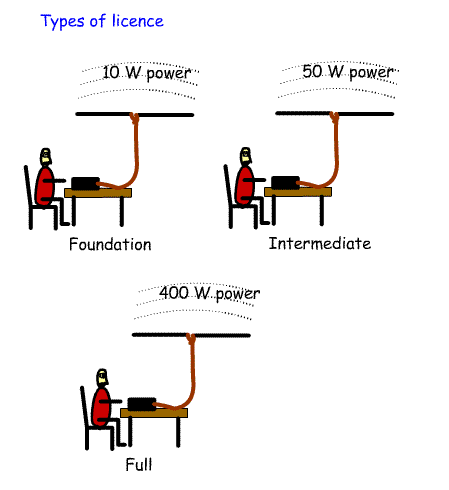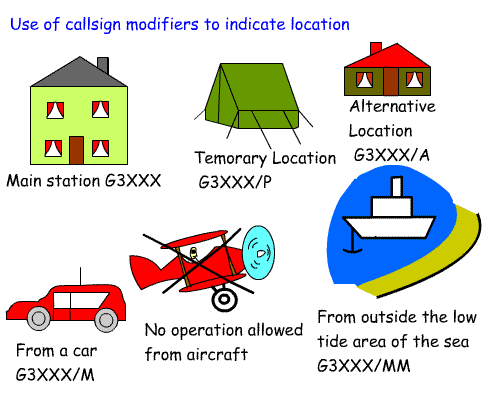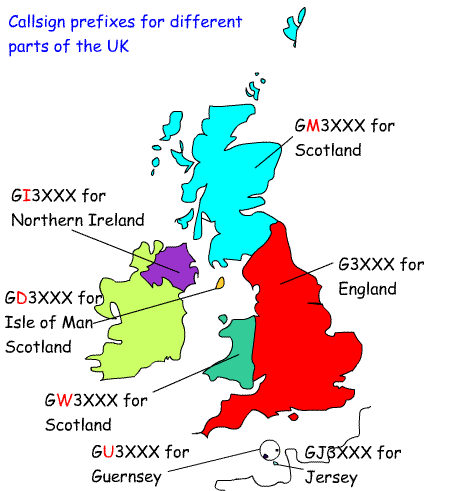
| ADVANCED LESSON 2 |  |
| LEARNING OBJECTIVES and NOTES |
|
| 2a Identify the types of UK licence and the format of all call signs in use including regional secondary locators, but NOT including club, special event and contest call signs. These can be found in the following sections of the Advanced Licence |
|
| 2(1) (a), (b), (c) and (d) 17(1) (b), (x) and (tt) Location There are three types of UK licence: Foundation - maximum power = 10W Intermediate -maximum power = 50W Full licence - maximum power = 400W and the ability to transmit from almost any country. In addition the following licences are also available: to holders of a full licence:: Special Event Station Licence (See lesson 66) Repeater Station Licence (See lesson 64) NOV Licence - NOV stands for Notice of Variation and is a licence issued for a particular band, such as 5MHz, which is not normally available to Radio Amateurs. You may operate your equipment from the Main Station Address (I.e. the one given on your licence); an Alternative Address ("Alternative Address” means a fixed postal address in the United Kingdom ; at a Temporary Location (e.g. the top of a mountain, the sea front at Blackpool; when Mobile ( mobile means in or on any vehicle or conveyance; II. on the person of the Licensee where the Licensee is a pedestrian; or III. on any Vessel on Inland Waters ("Vessel on Inland Waters” means a Vessel operating on the landward side of the low-water line along the coastline as marked on large scale charts officially recognised by the relevant coastal state) |

|
| 13(1), 2(2), 2(3) Notes (d) (e) Identity of Location When using Main Station Address there is nothing added to the call sign e.g. G3ABC When using an Alternative Address a /A is added to the call sign e.g. G3ABC/A When using a Temporary Location a /P is added to the call sign e.g. G3ABC/P When using Mobile a /M is added to the call sign e.g. G3ABC/M. NB The use of suffixes is not statutory. This means you can operate from any location using you home callsign only. 9(3) Non-use in aircraft, airborne vehicles including clause 17(1)(c) The Licensee shall not establish or use the Radio Equipment in any Aircraft or other Airborne Vehicle .“Aircraft” and “Airborne Vehicles” includes full size and models and also includes balloons whether tethered or free; This means that you cannot use a transmitter from a real aircraft, a model aircraft or a balloon. You are allowed to use a balloon to attach an antenna. |

|
|
The call sign should be modified if operating from a different part of the UK by adding a Secondary Locator letter
(a) England - No Regional Secondary Locator; e.g. G3ABC
(b) Guernsey - “U”; e.g. GU3ABC
(c) Isle of Man - “D”; e.g. GD3ABC
(d) Jersey - “J”; e.g. GJ3ABC
(e) Northern Ireland - “I”; e.g. GI3ABC
(f) Scotland - “M”; e.g. GM3ABC
(g) Wales - “W”.e.g. GW3ABC
If the Call sign begins with the number “2”, the provisions of Clause 2(2) shall apply with the addition that when used in England, the Secondary Locator “E” shall be used. e.g. 2E0ABC for England, 2W0ABC for Wales, 2M0ABC for Scotland Identification 13(1) The Licensee, or, if this Licence is a Full Licence, then any other authorised person who uses the Radio Equipment, shall transmit the Call sign and any Modifier applicable under the provisions of this Licence: (a) during initial calls (“CQ” calls) or calls to establish contact with another Amateur; (b) at least once every 15 minutes when the period of communication is longer than 15 minutes; (c) whenever the frequency of transmission is changed, at the beginning of transmission on the new frequency; (d) by the same type of transmission that is being used for the communication. This means that when you are having an SSB contact, you can't just send the call sign in CW. (e) on the same frequency that is being used for the communication |
. |